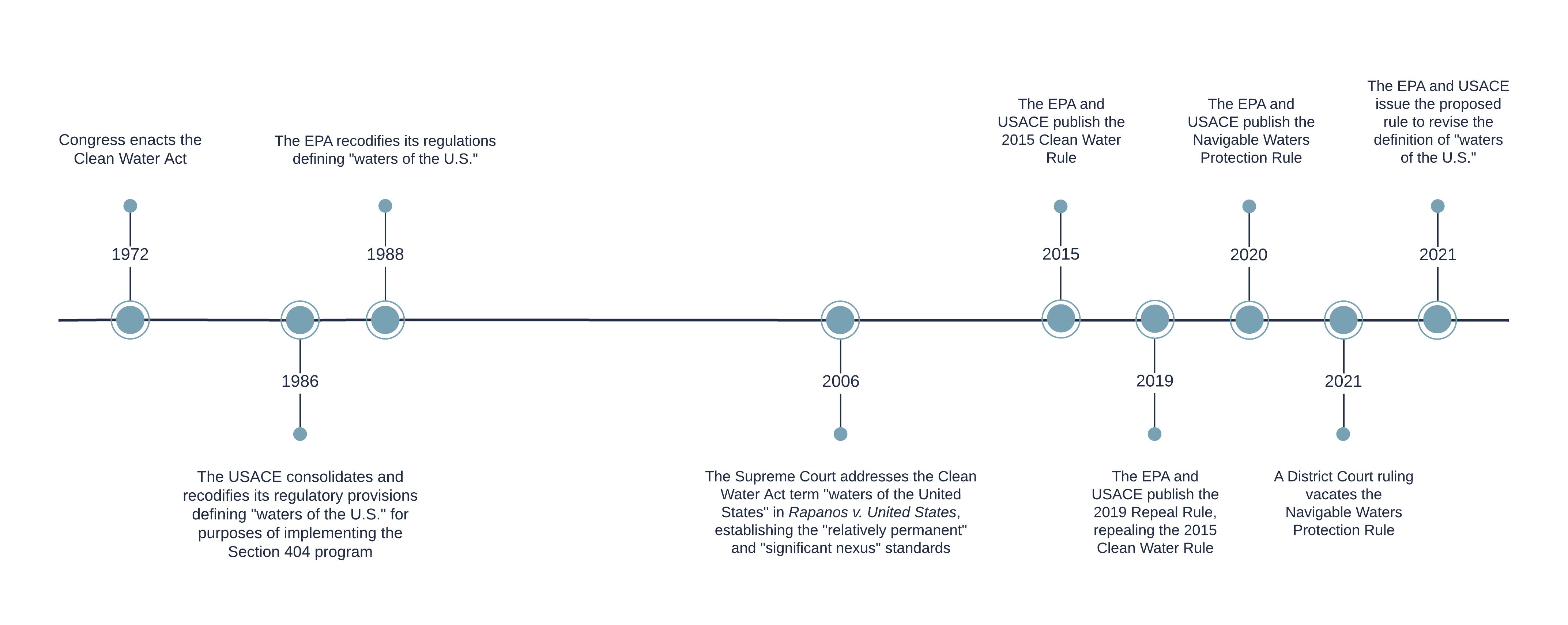
On November 18, 2021, the United States (U.S.) Environmental Protection Agency (EPA) and the U.S. Army Corps of Engineers (USACE) announced the issuance of a proposed rule to revise the definition of “waters of the U.S.” under the Clean Water Act to the pre-2015 definition (also referred to as the 1986 Regulations) with amendments informed by Supreme Court case law. The EPA and USACE are in the process of consulting with states, tribes, local governments, and stakeholders regarding the implementation of the proposed rule as well as the development of additional rules that build upon the regulatory framework of the proposed rule. A brief history of the events leading up to this announcement is shown in the following graphic.

The proposed rule replaces the 2020 Navigable Waters Protection Rule (NWPR), which went into effect in June 2020 and removed federal coverage from water features such as ephemeral tributaries, artificial lakes and ponds, and wetlands not directly connected to or closely separated from waters of the U.S. As mentioned in our 2021 Quarter 3 Regulatory Update, the NWPR was vacated by the U.S. District Court for the District of Arizona on August 30, 2021,and the EPA and Department of the Army have been implementing the pre-2015 regulatory regime since the NWPR was vacated. Because of this, the proposed rule will not result in any immediate significant changes to the implementation of the Clean Water Act but will provide a fixed regulatory standard to how waters of the U.S. will be defined moving forward.
Under the proposed rule, waters of the U.S. include the following:
- traditional navigable waters, interstate waters, and the territorial seas, as well as their adjacent wetlands;
- most impoundments of “waters of the U.S.;”
- tributaries to traditional navigable waters, interstate waters, the territorial seas, and impoundments that meet either the “relatively permanent” standard or the “significant nexus” standard;
- wetlands that are adjacent to impoundments and tributaries and meet either the “relatively permanent” standard or the “significant nexus” standard; and
- “other waters” that meet either the “relatively permanent” standard or the “significant nexus” standard.
The proposed rule defines how the EPA and USACE will interpret intervening Supreme Court decisions such as, United States v. Riverside Bayview Homes, 474 U.S. 121, 132 (1985); Solid Waste Agency of Northern Cook County v. U.S. Army Corps of Engineers, 531 U.S. 159 (2001); and Rapanos v. United States, 547 U.S. 715 (2006)(Rapanos). The most notable of these interpretations is the relatively permanent standard and the significant nexus standard from Rapanos, which have been added as an amendment to the 1986 Regulations in the proposed rule.
Under the relatively permanent standard, relatively permanent tributaries and adjacent wetlands that have a continuous surface connection to such tributaries are jurisdictional under the Clean Water Act as waters of the U.S. The proposed rule asserts jurisdiction over tributaries that are considered “relatively permanent” where waters typically (e.g., except due to drought) flow year-round or have a continuous flow at least seasonally. The agencies also assert jurisdiction over adjacent wetlands that have a continuous surface connection to a relatively permanent, non-navigable tributary.
The significant nexus standard as clarified by Justice Kennedy’s opinion in Rapanos is: “wetlands possess the requisite nexus, and thus come within the statutory phrase ‘navigable waters,’ if the wetlands, either alone or in combination with similarly situated lands in the region, significantly affect the chemical, physical, and biological integrity of other covered waters more readily understood as ‘navigable.’” (Rapanos at 780). The proposed rule will add the significant nexus and relatively permanent standards to the “other waters”, tributary, and adjacent wetland categories in the 1986 Regulations.
The EPA and USACE published the proposed rule to the Federal Register on December 7, 2021. The public comment period under the Administrative Procedures Act will close on February 7, 2022. Public hearings will be hosted virtually on January 12, January 13, and January 18, 2022. The agencies intend to issue an updated “Approved Jurisdictional Determination” form and instruction manual upon promulgating a final rule to aid the public and field staff in determining which waters are “waters of the U.S.” under the final rule. Information has not been released on the additional rules planned to be developed following the publication of the proposed rule.